|
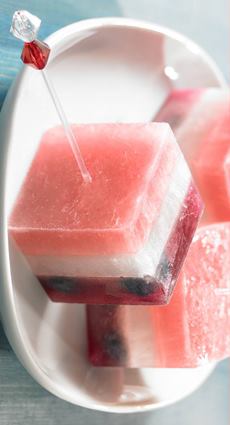
[1] Red and pink layered ice cubes (photos #1 and #2 © Ocean Spray).
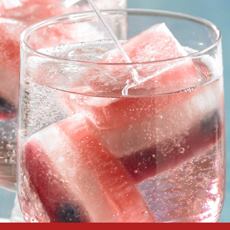
[2] Art in a glass.
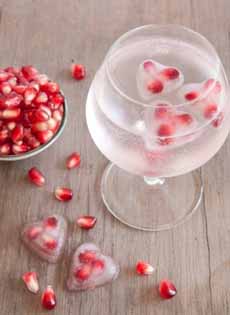
[3] Add some pomegranate ice cubes (here’s how from Kelly Elko).
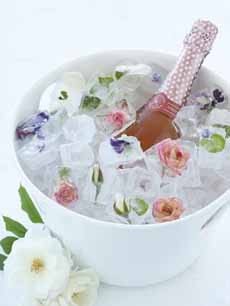
[4] Flower ice cubes: small flowers make a big impression (here’s how from Martha Stewart).
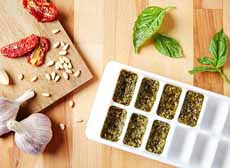
[5] More ways to use an ice cube tray: save pesto (photo courtesy P&G Every Day) or…
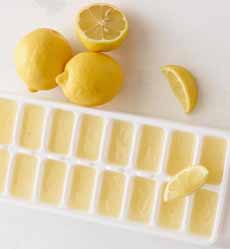
[6] lemon juice (photo courtesy Food Network).
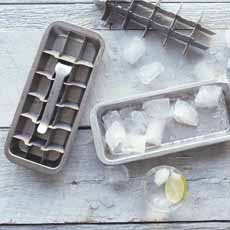
[7] The old-fashioned metal ice cube tray with a removable divider (photo © West Elm).
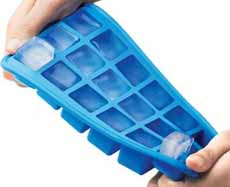
[8] Silicone trays make it easy to pop out the cubes (photo © Ikea).
|
|
These days, many people enjoy refrigerator-freezers with built-in ice makers.
But here’s a reason to hold on to those old-fashioned ice cube trays. In addition to party ice cubes, you can also use them to make granita—and much more, as you’ll see on the list below.
Because we’re days away from Valentine’s celebrations, how about some special ice? You can’t get these from a mechanical ice-cube maker!
RECIPE: LAYERED VALENTINE ICE CUBES
Ingredients Per Ice Cube Tray
1 ice cube tray
1 cup fresh blueberries, rinsed (substitute frozen blueberries)
1/3 cup Ocean Spray Blueberry Juice Cocktail
1/2 cup Ocean Spray White Cranberry Juice Drink
1/2 cup Ocean Spray Cranberry Juice Cocktail
Preparation
1. PLACE 4 blueberries in each of 16 ice cube cups. Add about 1 teaspoon blueberry flavored juice. Freeze for at least 1 hour or until solid.
2. ADD 1/2 tablespoon white cranberry drink to each cup, atop the frozen blueberry layer. Freeze for 1 hour or until solid.
3. TOP with 1/2 tablespoon cranberry beverage. Freeze for at least 1 hour or until solid.
OTHER VALENTINE ICE CUBES
Don’t have time or desire to layer ice cubes? These are much easier:
Aril ice cubes (photo #3): just water, pomegranate arils, and a heart-shaped ice cube tray.
Berry ice cubes (photo #4): make them with water or pomegranate juice, in regular or heart-shaped trays.
Flower ice cubes (photo #5): Add small flowers to water. If you’re using them in drinks, be sure the flowers are organic (otherwise they have pesticides).
Plain red or pink hearts: Add red fruit juice or pink lemonade to conventional ice cube trays.
MORE USES FOR ICE CUBE TRAYS
Certain foods are easier to pop out if you have silicone ice cube trays; others work better with a lever pull in an old-fashioned metal tray.
Once whatever you’re making is frozen, you can transfer the cubes to a freezer bag for storage. Here are some ideas to try.
Drinks
Chill beverages without diluting them. Make ice cubes with leftover coffee, tea, coconut milk, juice, etc. (freeze tomato juice for Bloody Marys).
Similarly, smoothies! Freeze fruits and vegetables to pop into the blender.
Make pretty ice cubes. Add berries, fruits, citrus peel, etc.
Deconstruct cocktails. For example, for a Piña Colada, try adding frozen pineapple juice and coconut cream cubes to a glass of rum.
Jell-O shots!
Desserts & Snacks
Make dessert bites. An ice cube tray is great for making miniature desserts, from fancy (chocolate-covered cherries) to casual (mini Rice Krispies Treats).
On-a-stick. From frozen cheesecake to juice pops and yogurt pops, you can make something different on a stick every week.
Make your own Chunkys & PB cups: Melt your chocolate of choice, blend in nuts, seeds, raisins, or other dried fruits; and set in the fridge. For peanut butter cups, layer melted chocolate and peanut butter and refrigerate until set.
Make chocolate squares. Fill the compartments partially, so you end up with bite-size chocolate tiles. Add whatever you like to flavor: spices, coconut, etc.
Cooking
For the first two: Once your cubes are frozen, pop them from the tray into a resealable freezer bag. For precise measures, determine in advance what the tray compartments hold.
Freeze extras and leftovers: From lemon juice and stock/broth to wine and bacon fat, you’ll have the perfect size to pop [frozen] into soups, stews, and sauces.
Freeze herbs. Hard herbs like oregano, sage, thyme, and rosemary defrost better than soft herbs like dill and basil. Pack the ice cube trays with 3/4 herbs and 1/4 olive oil. Toss a cube directly into the pan to season eggs, sauces, etc.
Freeze garlic and ginger. First, purée them before adding them to the compartments. This also works with pesto (as is—no additional work required).
Freeze buttermilk. Buttermilk is pricey, and a recipe often requires just a quarter or half a cup. Freeze the leftover buttermilk; you’ll need it again soon.
Make sushi. It’s hard for amateurs to hand-form nigiri rice beds. Fill the compartments with seasoned rice, pop them out, and lay the fish or other toppings onto them.
More Uses
There are household uses, from homemade detergent cubes to sprouting seedlings. Just look online!
HISTORY OF THE ICE CUBE TRAY
Before the advent of the ice cube tray, ice for drinks and similar purposes was chipped from large blocks with an ice pick.
An American physician, John Gorrie, built a refrigerator in 1844 to make ice to cool the air for his yellow fever patients. The refrigerator produced ice, which he hung from the ceiling in basins to cool the hot air.
Some historians believed that Dr. Gorrie also invented the first ice cube tray in its current form. He is known to have given his patients iced drinks to cool them down.
The Domestic Electric Refrigerator, produced in 1914 by Fred Wolf, contained a simple ice cube tray.
By the 1920s and 1930s ice cube trays were commonplace in refrigerators.
The first flexible ice tray was launched in 1933, invented by Guy Tinkham. Silicone was still decades ahead; Tinkham’s tray stainless steel, with points that would eject the ice cubes.
The first rubber ice cube tray was launched by Lloyd Groff Copeman, also in 1933. Five years earlier, he had noticed that slush and ice flaked off his rubber boots, and set about designing different types of rubber trays.
WHAT ABOUT CLOUDY ICE CUBES?
You may have noted that commercially-made ice cubes are completely clear, while homemade cubes from the fridge are cloudy in the center.
|









